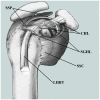Small-incision open distal subpectoral vs. arthroscopic proximal biceps tenodesis for biceps long head tendon lesions with repair of rotator cuff tears
- PMID: 32010246
- PMCID: PMC6966230
- DOI: 10.3892/etm.2019.8284
Small-incision open distal subpectoral vs. arthroscopic proximal biceps tenodesis for biceps long head tendon lesions with repair of rotator cuff tears
Abstract
The curative effect of small-incision open distal subpectoral vs. arthroscopic proximal biceps tenodesis for lesions in the long head of the biceps tendon (LHBT) combined with rotator cuff repairs (RCR) has remained controversial. The aim of the present study was to compare the two surgical methods. A total of 71 patients who received surgical treatment for LHBT lesions accompanied by RC tears were analyzed. Following arthroscopic RCR and tendectomy of the affected LHBT, 35 patients underwent small-incision open distal subpectoral tenodesis through a small incision (the subpectoral group), while the remaining 36 patients received arthroscopic proximal tenodesis (the arthroscopic group). The surgery time and intra-operative blood loss were compared between the two groups. In addition, the clinical outcomes were evaluated using scoring systems for the functional assessment of the shoulder joint. The subpectoral group had a shorter surgery time and less intra-operative blood loss than the arthroscopic group (P<0.05). The functional scores of the two groups significantly improved as time passed (P<0.05). The subpectoral group was significantly superior to the arthroscopic group with regard to the American Shoulder and Elbow Surgeons score at 2 weeks post-operatively and visual analog scale score at 2 weeks and 3 months post-operatively (P<0.05). Small-incision open distal subpectoral and arthroscopic proximal tenodesis were demonstrated to effectively improve the function of the shoulder joint and relieve pain caused by LHBT lesions accompanied by RCR. However, small-incision open distal subpectoral tenodesis had the additional advantage of shorter surgery time, less intra-operative bleeding and encouraging early results compared to arthroscopic proximal tenodesis. The study was registered as a clinical trial in the Chinese Trial Registry (no. ChiCTR1800015643).
Keywords: arthroscopy; pectoralis muscles; rotator cuff; tendon; tenodesis.
Copyright: © Yi et al.
Figures





Similar articles
-
Arthroscopic proximal versus open subpectoral biceps tenodesis with arthroscopic repair of small- or medium-sized rotator cuff tears.Knee Surg Sports Traumatol Arthrosc. 2016 Dec;24(12):3772-3778. doi: 10.1007/s00167-015-3641-5. Epub 2015 Jun 4. Knee Surg Sports Traumatol Arthrosc. 2016. PMID: 26040653
-
Rotator cuff tear with concomitant long head of biceps tendon (LHBT) degeneration: what is the preferred choice? Open subpectoral versus arthroscopic intraarticular tenodesis.J Orthop Traumatol. 2019 Jul 5;20(1):26. doi: 10.1186/s10195-019-0531-5. J Orthop Traumatol. 2019. PMID: 31278446 Free PMC article. Clinical Trial.
-
Lesions of the Long Head of the Biceps Tendon Concomitant with Rotator Cuff Tears: Tenotomy or Subpectoral Mini-open Tenodesis? A Comparative Short to Mid-term Follow-up Study.Orthop Surg. 2019 Oct;11(5):857-863. doi: 10.1111/os.12536. Epub 2019 Sep 18. Orthop Surg. 2019. PMID: 31532924 Free PMC article.
-
Outcomes and Complications After Primary Arthroscopic Suprapectoral Versus Open Subpectoral Biceps Tenodesis for Superior Labral Anterior-Posterior Tears or Biceps Abnormalities: A Systematic Review and Meta-analysis.Orthop J Sports Med. 2020 Aug 28;8(8):2325967120945322. doi: 10.1177/2325967120945322. eCollection 2020 Aug. Orthop J Sports Med. 2020. PMID: 32923502 Free PMC article. Review.
-
Surgical treatment for long head of the biceps tendinopathy: a network meta-analysis.J Shoulder Elbow Surg. 2020 Jun;29(6):1289-1295. doi: 10.1016/j.jse.2019.10.021. Epub 2020 Feb 6. J Shoulder Elbow Surg. 2020. PMID: 32037231
Cited by
-
Biceps Tenodesis versus Tenotomy with Fast Rehabilitation Protocol-A Functional Perspective in Chronic Tendinopathy.J Clin Med. 2020 Dec 4;9(12):3938. doi: 10.3390/jcm9123938. J Clin Med. 2020. PMID: 33291804 Free PMC article.
-
Higher complication rate is associated with suprapectoral biceps tenodesis as compared to subpectoral tenodesis: a systematic review and meta-analysis of comparative studies.Eur J Orthop Surg Traumatol. 2025 Feb 25;35(1):75. doi: 10.1007/s00590-025-04196-6. Eur J Orthop Surg Traumatol. 2025. PMID: 39998641
-
Surgical treatment of long head of biceps pathology: analyzing trends in the United States from 2010 to 2019.JSES Rev Rep Tech. 2025 Jan 23;5(2):160-169. doi: 10.1016/j.xrrt.2024.12.013. eCollection 2025 May. JSES Rev Rep Tech. 2025. PMID: 40321877 Free PMC article.
-
Arthroscopic intra-articular vs. subpectoral biceps tenodesis with concomitant rotator cuff repair leads to equivocal MCID achievement.JSES Int. 2025 Feb 14;9(3):728-734. doi: 10.1016/j.jseint.2025.01.020. eCollection 2025 May. JSES Int. 2025. PMID: 40486765 Free PMC article.
-
Onlay Versus Inlay Biceps Tenodesis for Long Head of Biceps Tendinopathy: A Systematic Review and Meta-analysis.J Am Acad Orthop Surg Glob Res Rev. 2022 Dec 9;6(12):e22.00255. doi: 10.5435/JAAOSGlobal-D-22-00255. eCollection 2022 Dec 1. J Am Acad Orthop Surg Glob Res Rev. 2022. PMID: 36732300 Free PMC article.
References
-
- Landreau P, Catteeuw A, Hamie F, Saithna A, Sonnery-Cottet B, Smigielski R. Anatomic study and reanalysis of the nomenclature of the anterolateral complex of the knee focusing on the distal iliotibial band: Identification and description of the condylar strap. Orthop J Sports Med. 2019;7:2325967118818064. doi: 10.1177/2325967118818064. - DOI - PMC - PubMed
LinkOut - more resources
Full Text Sources
